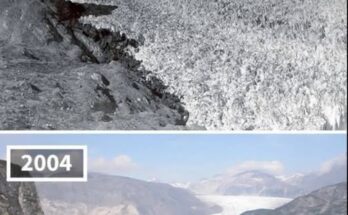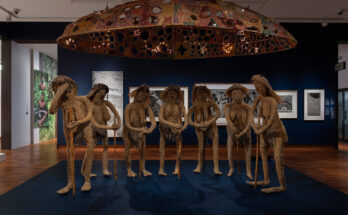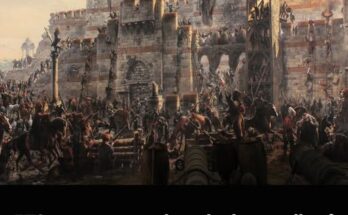High upon the arid sandstone plateau of Tassili n’Ajjer, deep in the heart of the Algerian Sahara, lies one of humanity’s most astounding archaeological treasures. This UNESCO World Heritage Site, often referred to as an “open-air museum,” houses thousands of rock engravings and cave paintings dating from circa 7000 BCE to 2000 BCE. Stretching over 72,000 square kilometers, the site presents an extraordinary chronicle of prehistoric life, climate evolution, spiritual beliefs, and early human creativity.
These artworks, some as vivid and expressive today as they were thousands of years ago, offer a rare and powerful glimpse into early human civilization in North Africa. They span millennia, recording the transition of the Sahara from a lush, fertile savannah teeming with life to the arid desert we see today. The images are not merely decorative; they are testimonies of an ancient way of life, coded into stone for eternity.

Though local Tuareg populations had long known of the paintings, the site came to international attention in the early 20th century. French archaeologist Henri Lhote led expeditions in the 1930s and 1950s, documenting thousands of images and sparking global interest in the site. He referred to Tassili as “the greatest museum of prehistoric art in the world.” Today, it stands alongside Lascaux in France and Altamira in Spain as one of the most significant collections of prehistoric art ever discovered.
What makes Tassili n’Ajjer especially significant is the span of time it covers. The artworks are not static remnants from one cultural moment, but dynamic visual records of successive civilizations and ecological changes. They help scholars trace cultural evolution, spiritual systems, and even possible early contact between African and Mediterranean peoples.
II. Context: A Green Sahara
To understand the paintings, one must first grasp the startling fact that the Sahara was not always a desert. Between roughly 9000 BCE and 3000 BCE, North Africa experienced what scientists call the African Humid Period. Rainfall was abundant, rivers flowed freely, and the region was rich in flora and fauna.
The cave paintings of Tassili n’Ajjer depict this Edenic landscape in exquisite detail. Herds of elephants, giraffes, ostriches, antelope, and even crocodiles roam through these scenes—animals that could not survive in the Sahara today. The presence of such animals indicates an ecosystem resembling that of modern East African savannahs.
These images are more than nostalgic documentation; they are living records of climate change. As rainfall decreased and desertification advanced, the paintings themselves changed—reflecting shifts in diet, migration, and spiritual practice.
III. Artistic Styles and Periods
Scholars generally divide the Tassili rock art into five main chronological periods, each with distinct stylistic and thematic features:
1. Archaic or Bubaline Period (c. 10,000–7,000 BCE)
This oldest phase features naturalistic depictions of wild animals like buffalo (hence the name “Bubaline”), elephants, and rhinoceroses. Human figures are rare or absent. The emphasis is on majestic, free-roaming fauna, painted in red ochre and often engraved into stone.
2. Round Head Period (c. 7000–6000 BCE)
This is perhaps the most mysterious and spiritually charged phase. Human figures dominate the art, often painted with exaggerated, round heads and no facial features. These beings appear to float, dance, or engage in ritual acts—suggesting shamanistic practices or spiritual ceremonies. Some researchers interpret these as depictions of trance states or contact with other realms.
3. Pastoral Period (c. 5500–2000 BCE)
As the climate became drier, pastoralism replaced hunting and gathering. This period features numerous scenes of domestic life: herding cattle, milking animals, cooking, dancing, and social gatherings. Human figures are more realistic, and men, women, and children are clearly differentiated.
The cattle are elaborately depicted—often with decorative horns, bridles, or markings—highlighting their spiritual and economic value. Tassili becomes a window into early animal domestication and human adaptation to environmental stress.
4. Horse Period (c. 1200–700 BCE)
This period coincides with the spread of horse domestication and likely indicates contact with Mediterranean cultures. Chariots and horses appear, signaling not only technological advancement but possibly social hierarchy and warfare. The art style becomes more linear and abstract.
5. Camel Period (c. 200 BCE–present)
Camels, absent from earlier art, now dominate the images. This marks the final transformation of the Sahara into a true desert. The appearance of camels—used for trade and travel—signals a shift into historical times and trans-Saharan commerce.
IV. Human Figures and Social Structure
The human figures in Tassili n’Ajjer are striking in their diversity and complexity. In the Round Head period, humans are faceless and alien-like, suggesting a focus on spirituality or altered consciousness. These figures often appear in what seem to be ritual dances, accompanied by strange symbols and motifs.
In later periods, more naturalistic depictions show men with bows, women carrying water or children, and even people engaged in musical performance. One mural shows a man holding a long trumpet-like instrument—possibly an early form of horn or flute. Others depict complex hunting scenes or communal activities.
The attention to detail—elaborate hairstyles, clothing, body paint—suggests a sophisticated society with gender roles, aesthetics, and ceremonial customs. These are not simplistic cavemen but nuanced, artistic people deeply embedded in cultural and environmental cycles.
V. Spirituality and Symbolism
Many researchers believe the art has a strong spiritual or religious component. In the Round Head period especially, images of floating figures, strange masks, and out-of-body postures evoke shamanic rituals. Some scholars suggest that these figures represent deities, spirits, or metaphysical journeys induced by trance or hallucinogenic plants.
The rock surfaces themselves may have been considered sacred. Placement of the paintings—deep within caves, high on cliffs, or hidden among boulders—implies deliberate, meaningful choices. These were not random doodles but acts of reverence and communication.
Symbols such as circles, zigzags, and dots appear frequently, possibly representing water, energy, or cosmological maps. While their meanings remain speculative, their recurrence across different sites and periods points to a shared symbolic language.
VI. Technique and Materials
The artists of Tassili n’Ajjer employed a sophisticated range of techniques, including engraving, incising, painting, and stenciling. Natural pigments such as ochre, iron oxide, and charcoal were mixed with plant oils or animal fats to produce durable paints.
Despite the harsh conditions, many of these images remain remarkably well preserved due to the region’s dryness and the protective nature of rock shelters. Some paintings are as vivid today as they were 8,000 years ago.
The artists also understood composition and movement. Figures are often depicted in action—running, jumping, throwing spears—giving a kinetic energy that rivals modern illustration.
VII. Controversies and Mysteries
The Tassili paintings have sparked intense debates, especially among those fascinated by ancient astronauts or lost civilizations. Some Round Head figures, with their large heads and featureless faces, have been interpreted (controversially) as evidence of extraterrestrial contact.
Others see parallels between Tassili art and Neolithic European symbols, suggesting a wider prehistoric cultural exchange. While these theories often lack concrete evidence, they underscore how powerfully the images ignite the imagination.
A more grounded mystery remains: Why did this culture disappear? Was it purely environmental collapse, or were there other socio-p


